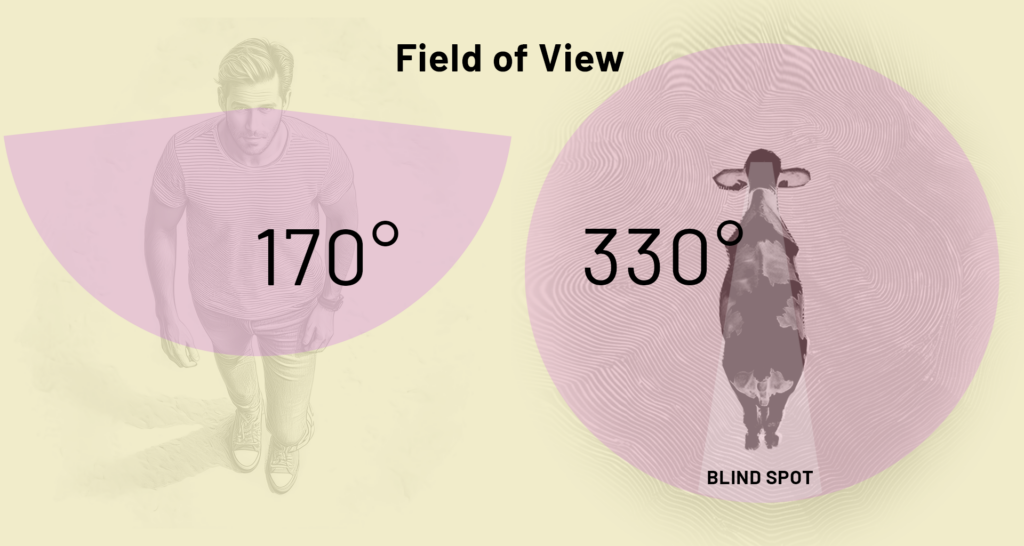Series 2: cows, donkeys, and horses
Field of View
Comparison of the field of view between a human and a cow.

Some Random Facts about Horse Vision
- The range of a horse’s monocular vision, blind spots are in shaded areas
- A horse can use binocular vision to focus on distant objects by raising its head.
- Horse eyes are among the largest of any land mammal, and are positioned on the sides of the head (that is, they are positioned laterally).
- This means horses have a range of vision of about 350°, with approximately 65° of this being binocular vision and the remaining 285° monocular vision.
- This provides a horse with the best chance to spot predators.
- The horse’s wide range of monocular vision has two “blind spots,” or areas where the animal cannot see: in front of the face, in front of the horse, and right behind its head
- The wide range of monocular vision has a trade-off: The placement of the horse’s eyes decreases the possible range of binocular vision to around 65° on a horizontal plane, occurring in a triangular shape primarily in front of the horse’s face. Therefore, the horse has a smaller field of depth perception than a human.
- The horse uses its binocular vision by looking straight at an object,
- To use binocular vision on a closer object near the ground, such as a snake or threat to its feet, the horse drops its nose and looks downward with its neck somewhat arched.
- A horse will raise or lower its head to increase its range of binocular vision.
- The horse has a “visual streak”, or an area within the retina, linear in shape, with a high concentration of ganglion cells (up to 6100 cells/mm2 in the visual streak compared to the 150 and 200 cells/mm2 in the peripheral area).
- Horses have better acuity when the objects they are looking at fall in this region.
- They therefore will tilt or raise their heads, to help place the objects within the area of the visual streak.
- The horse is very sensitive to motion, as motion is usually the first alert that a predator is approaching. Such motion is usually first detected in their periphery, where they have poor visual acuity, and horses will usually act defensive and run if something suddenly moves into their peripheral field of vision.
- Horses are not color blind, they have two-color, or dichromatic vision.
- This means they distinguish colors in two wavelength regions of visible light, compared to the three-color (trichromic vision) of most humans.
- In other words, horses naturally see the blue and green colors of the spectrum and the color variations based upon them, but cannot distinguish red.
- Research indicates that their color vision is somewhat like red-green color blindness in humans, in which certain colors, especially red and related colors, appear more green.
- Dichromatic vision is the result of the animal having two types of cones in their eyes.
- A short-wavelength-sensitive cone (S) that is optimal at 428 nm (blue), and a middle-to-long wavelength sensitive cone (M/L) which sees optimally at 539 nm, more of a yellowish color.
- This structure may have arisen because horses are most active at dawn and dusk, a time when the rods of the eye are especially useful.
- Horses have more rods than humans, a high proportion of rods to cones (about 20:1), as well as a tapetum lucidum, giving them superior night vision.
- This also gives them better vision on slightly cloudy days, relative to bright, sunny days.
- The large eye of the horse improves achromatic tasks, particularly in dim conditions, which presumably assists in the detection of predators
- Laboratory studies show horses are able to distinguish different shapes in low light, including levels mimicking dark, moonless nights in wooded areas.
- However, horses are less able to adjust to sudden changes of light than are humans, such as when moving from a bright day into a dark barn.
- Many domestic horses (about a third) tend to have myopia (near-sightedness), with few being far-sighted.
- Wild horses, however, are usually far-sighted.
- Head movements are linked to the horse’s use of its binocular field rather than to focus requirements.
Click Here to Read the Entire Article:
Published: April 8, 1984
The perception of color by cattle and its influence on behavior
Abstract: Experiments have suggested that cattle can only discriminate long wavelengths of light (colored red) from short (blue) or medium (green) wavelengths, and not short from medium wavelengths; however, stimuli were inadequately balanced for intensity. In this study, an initial group of calves was trained to discriminate light sources by intensity, and the intensities of short, medium, and long wavelength lights were then varied to determine when the calves perceived them to be isoluminant.
Published: November 12, 2008
The Absolute Threshold of Colour Vision in the Horse
Abstract: Arrhythmic mammals are active both during day and night if they are allowed. The arrhythmic horses are in possession of one of the largest terrestrial animal eyes and the purpose of this study is to reveal whether their eye is sensitive enough to see colours at night. During the day horses are known to have dichromatic colour vision. To disclose whether they can discriminate colours in dim light a behavioural dual choice experiment was performed. We started the training and testing at daylight intensities and the horses continued to choose correctly at a high frequency down to light intensities corresponding to moonlight. One Shetland pony mare, was able to discriminate colours at 0.08 cd/m2, while a half blood gelding, still discriminated colours at 0.02 cd/m2. For comparison, the colour vision limit for several human subjects tested in the very same experiment was also 0.02 cd/m2. Hence, the threshold of colour vision for the horse that performed best was similar to that of the humans. The behavioural results are in line with calculations of the sensitivity of cone vision where the horse eye and human eye again are similar. The advantage of the large eye of the horse lies not in colour vision at night, but probably instead in achromatic tasks where presumably signal summation enhances sensitivity.
Published September 9, 2020
Sensory Abilities of Horses and Their Importance for Equitation Science
Abstract: Vision, hearing, olfaction, taste, and touch comprise the sensory modalities of most vertebrates. With these senses, the animal receives information about its environment. How this information is organized, interpreted, and experienced is known as perception. The study of the sensory abilities of animals and their implications for behavior is central not only to ethology but also to animal welfare. Sensory ability, perception, and behavior are closely linked. Horses and humans share the five most common sensory modalities, however, their ranges and capacities differ, so that horses are unlikely to perceive their surroundings in a similar manner to humans. Understanding equine perceptual abilities and their differences is important when horses and human interact, as these abilities are pivotal for the response of the horse to any changes in its surroundings. This review aims to provide an overview of the current knowledge on the sensory abilities of horses. The information is discussed within an evolutionary context and also includes a practical perspective, outlining potential ways to mitigate risks of injuries and enhance positive horse-human interactions. The equine sensory apparatus includes panoramic visual capacities with acuities similar to those of red-green color-blind humans as well as aural abilities that, in some respects exceed human hearing and a highly developed sense of smell, all of which influence how horses react in various situations. Equine sensitivity to touch has been studied surprisingly sparingly despite tactile stimulation being the major interface of horse training. We discuss the potential use of sensory enrichment/positive sensory stimulation to improve the welfare of horses in various situations e.g. using odors, touch or sound to enrich the environment or to appease horses. In addition, equine perception is affected by factors such as breed, individuality, age, and in some cases even color, emphasizing that different horses may need different types of management. Understanding the sensory abilities of horses is central to the emerging discipline of equitation science, which comprises the gamut of horse-human interactions. Therefore, sensory abilities continue to warrant scientific focus, with more research to enable us to understand different horses and their various needs.

